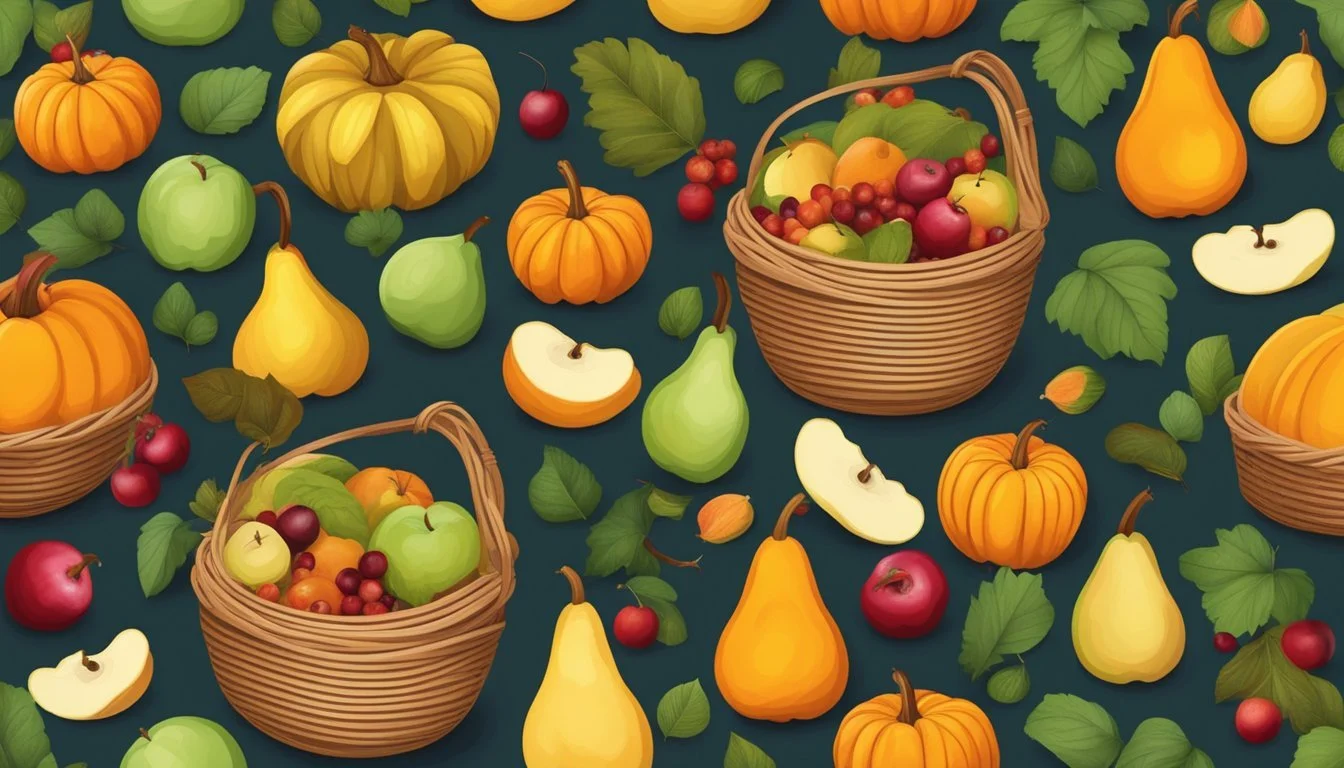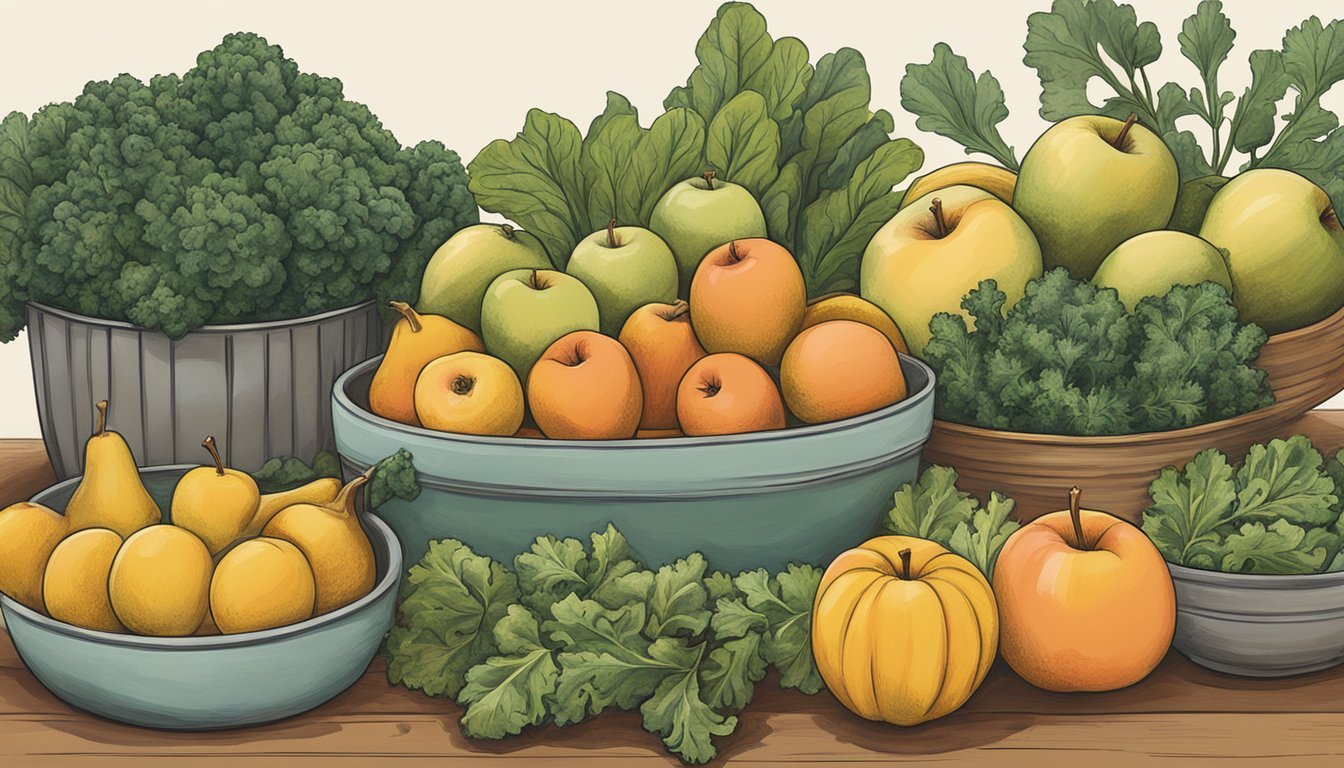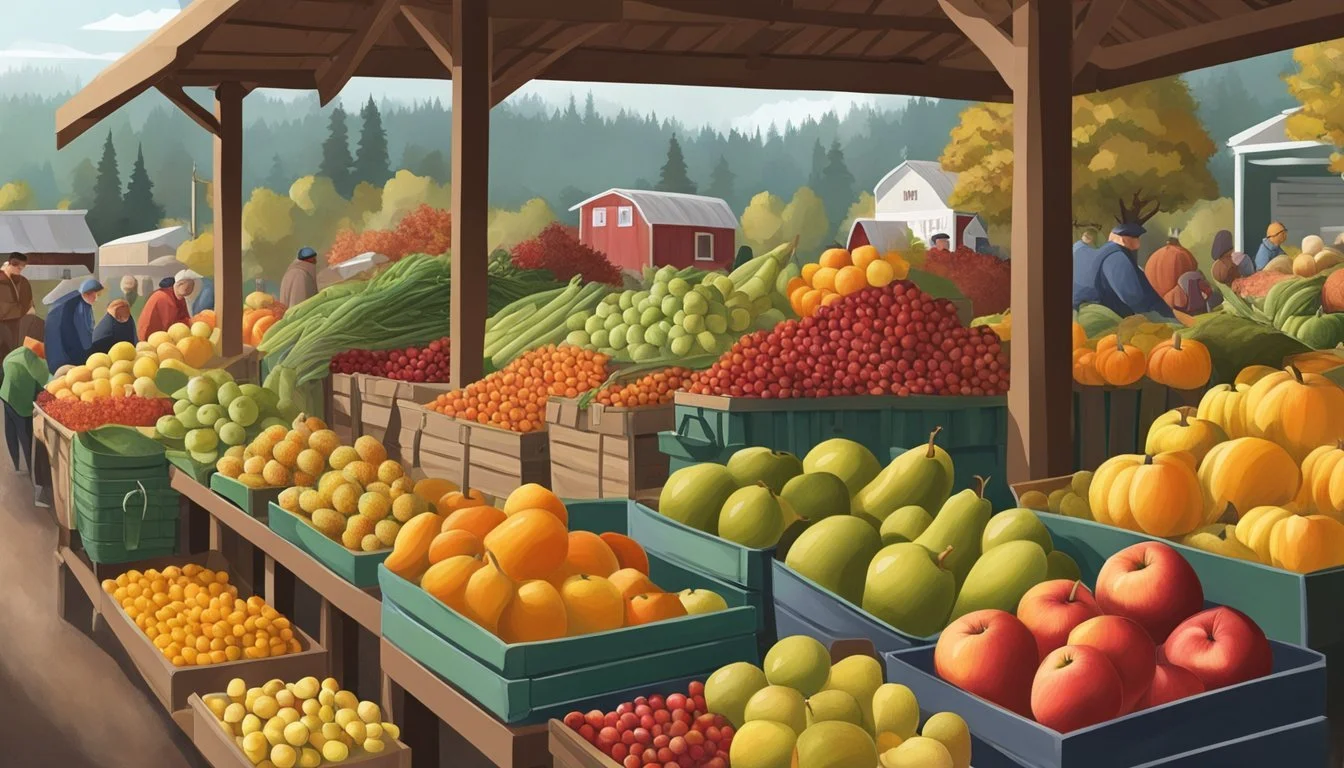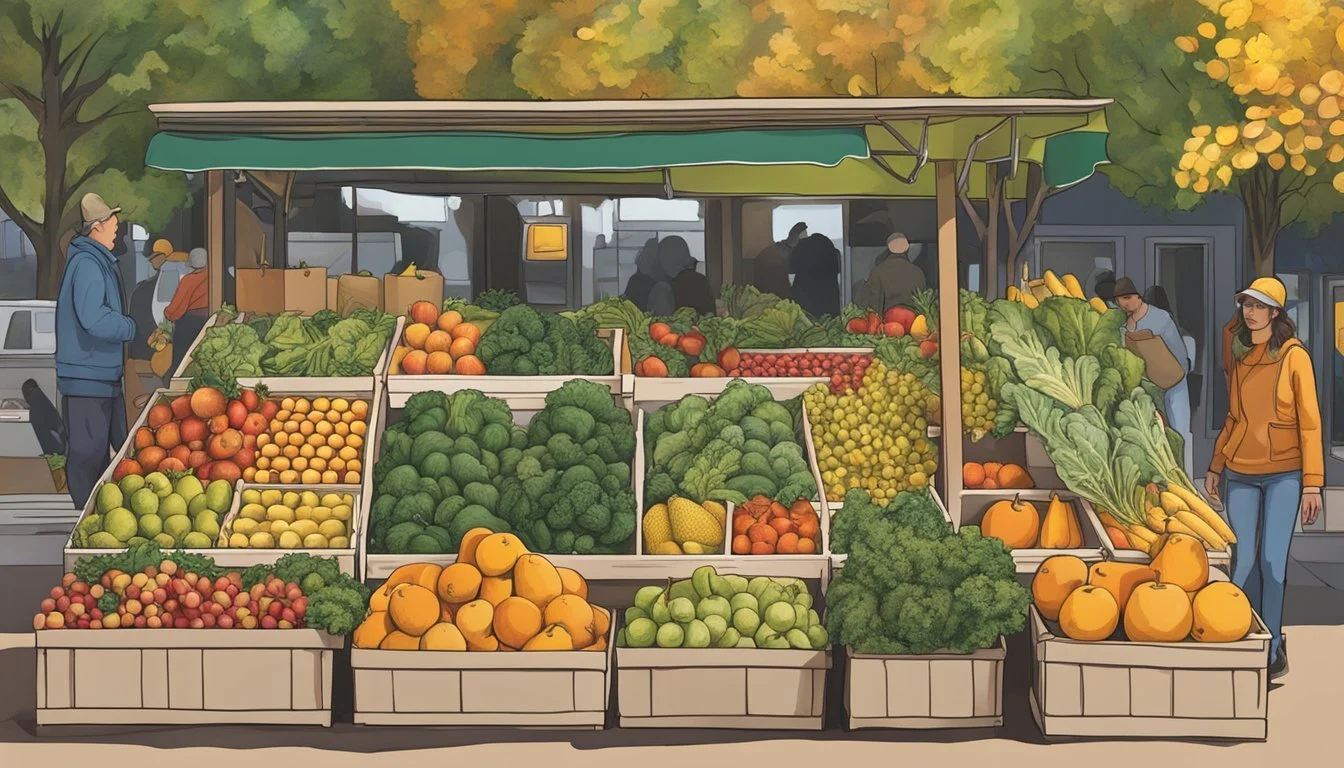Oregon Seasonal Fruit & Vegetables in November
A Guide to Local Produce
This Article is Part of our Oregon Seasonal Fruit & Veg Calendar
As November arrives, Oregon's rich soils and varied climate yield a bountiful harvest of seasonal fruits and vegetables. During this month, the state's agricultural focus shifts towards produce that can thrive in cooler temperatures, showcasing the adaptability and diversity of Oregon's farming practices. While some late-summer crops reach the end of their season, others reach their peak, offering Oregonians and visitors alike an array of fresh, locally-sourced options.
Within the cooler embrace of November, many of Oregon's orchards and fields are still full of life. Root vegetables and hardy greens dominate the scene, with produce like beets (how long do beets last?) and Brussels sprouts (how long do brussels sprouts last?) coming into prime season. These, along with a variety of cabbages and carrots, are staples in the local diet and are renowned for their flavor and nutritional value. Late-season apples and pears continue to be harvested, ensuring that fruit remains a key component of the seasonal menu.
Oregon's dedication to sustainable agriculture means that even as winter approaches, the focus on in-season, locally-grown produce does not wane. The commitment to providing fresh, high-quality fruits and vegetables is evident in the state's numerous farmers' markets and community-supported agriculture programs, which celebrate the seasonal bounty. November's offerings are a testament to the resilience of Oregon's agriculture and the careful stewardship of its land.
Fruits Available in November
During November in Oregon, the fruit selection begins to reflect the impending winter. Consumers can look forward to a variety of tree fruits and a limited selection of berries that thrive in the cooler weather.
Tree Fruits
In November, tree fruits in Oregon are typically reaching the end of their season, yet a few varieties remain available.
Apples: A staple in November, varieties like Fuji, Granny Smith, and Pink Lady are commonly found.
Pears: Bartlett and Comice pears are still in season, offering a buttery and sweet flavor.
Persimmons: This unique fruit comes into season, providing a sweet, honey-like taste when fully ripe.
Quince: Although less common, quince is available and is best used in cooked dishes as it's quite tart when raw.
Berries
Berry options are sparse in November, as most varieties have ended their season.
However, evergreen huckleberries may still be foraged in some areas, weather permitting.
Vegetables Available in November
November in Oregon introduces a robust selection of cool-weather crops, with an emphasis on hearty root vegetables and a variety of nutrient-rich greens and cruciferous offerings.
Root Vegetables
In the chill of November, root vegetables thrive, providing a variety of textures and flavors. Beets and carrots are at their sweetest, having benefited from the cold soil temperatures that concentrate their natural sugars. Potatoes are also readily available, offering a staple for many comfort dishes in the fall. Other roots like radishes, rutabagas, and turnips offer earthy flavors perfect for roasting or adding to stews.
Beets: Sweet and earthy, ideal for roasting or pickling.
Carrots: Crunchy and sweet, versatile across culinary uses.
Potatoes: Staple vegetable, great for boiling, mashing, or baking.
Radishes: Crisp and peppery, a colorful addition to salads.
Rutabagas: Mild and sweet, suitable for mashing or roasting.
Turnips: Tend to be slightly peppery, good in mixed vegetable roasts.
Cruciferous Vegetables
The cruciferous family shines in November with cabbage providing a base for slaws and ferments, while Brussels sprouts and cauliflower emerge as favorites for their adaptability in dishes whether roasted, steamed, or shredded raw into salads. These vegetables are known not only for their taste but also for their health benefits, including high vitamin content and cancer-fighting properties.
Cabbage: Offers a crisp texture, used in salads and sauerkraut.
Brussels Sprouts: Small and leafy, best when roasted until caramelized.
Cauliflower: Mild flavor, can be roasted whole, turned into rice, or used in bakes.
Leafy Greens
Leafy greens such as kale, (What wine goes well with kale?) arugula (how long does arugula last?), chard, and spinach are in abundance, their flavors enhanced by the cooler weather. These greens offer versatility, from raw in salads to a cooked accompaniment, and are important for their high vitamin density and iron content.
Kale: Robust and slightly bitter, stands up well to cooking.
Arugula: Has a distinctive peppery flavor, often used fresh in salads.
Chard: Offers large, tender leaves and colorful stems with a mild flavor.
Spinach: Delicate and mild, can be eaten raw or just wilted into dishes.
Herbs and Others
In November, Oregon's diverse climate allows for a variety of herbs to be at their best. One herb of particular note is sage, a staple in many fall dishes, especially popular during Thanksgiving meals. Herbs in general tend to be hardy and can continue to flourish in the cooler temperatures of the Oregonian late autumn.
Sage:
Availability: Thrives in November, making it a fresh addition to seasonal recipes.
Uses: Essential for poultry seasoning and pairs well with squash and pork.
Other Herbs: While not as prominent as sage, other herbs also play a significant role in November's harvest. These include:
Basil: Before the first frost ends its season, basil is commonly harvested and preserved.
Parsley: Adds a fresh flavor to dishes, available throughout the season.
Rosemary: Its robust flavor complements heartier cold-weather meals.
Gardeners in Oregon typically prepare these herbs for the winter month by harvesting and preserving them in various forms, such as drying or creating herb-infused oils. This ensures that a touch of fresh, local flavor is available even as the colder months set in.
Preparation and Storage Tips
In November, Oregon's seasonal fruits and vegetables are at their peak and require careful storage and preparation to maintain their quality. Proper techniques ensure these items retain their flavor and nutritional value.
Storing for Freshness
Leafy Greens (such as chard and collard greens): These should be stored unwashed in a plastic bag in the refrigerator's crisper drawer where they can stay fresh for up to five days.
Root Vegetables (like sweet potatoes): Keep them in a cool, dark, and well-ventilated place. They can last for about a month when stored properly.
Fruits (including apples): Store apples in a plastic bag in the refrigerator away from vegetables to prevent them from absorbing the ethylene gas that apples emit, which can shorten their shelf life.
Herbs: To extend their freshness, wrap them in a damp paper towel and place them in a bag in the refrigerator.
Preparation Methods
Roasting: Root vegetables like sweet potatoes can be cut into chunks, drizzled with olive oil, and seasoned before roasting to enhance their natural sweetness.
Soups and Stews: Use a variety of November vegetables to create hearty soups and stews. These dishes often have a better flavor the next day, as the ingredients have more time to meld together.
Raw: Some produce, such as apples, are best enjoyed raw to appreciate their crisp texture and full flavor profile.
Recipes: Leverage seasonal produce in recipes that highlight their freshness. For instance, incorporate roasted sweet potatoes into salads or soups for added richness and flavor.
Always handle produce with care to maintain its quality from the store to your table.
Seasonal Eating Benefits
Engaging in seasonal eating has advantages directly tied to the flavors, climate, and crops of a specific region. In Oregon, seasonal eating during November means consuming fruits and vegetables that are harvested at their peak.
Flavor
Fruits and vegetables picked during their optimal months, such as beets and Brussels sprouts in November, tend to be more flavorful. This is because they naturally ripen and are harvested at the right time, ensuring maximum taste.
Climate
The climate of Oregon supports the growth cycles of various crops. Seasonal eating respects and aligns with these natural cycles, reducing the need for artificial ripening agents and extended storage times, which can diminish food quality.
Local Crops
Focusing on local crops available in November, such as kale and winter squash, benefits consumers by providing fresher options. It also supports Oregon farmers and minimizes the environmental impact of long-distance transportation.
Enjoying Seasonal Produce in Oregon
Beets: Harvested June through January
Brussels Sprouts: Available September through January
Kale: Remains in season well into winter months
Squash: Includes varieties like butternut and acorn, prime in fall and early winter
Adapting diets to include seasonal foods contributes to better nutrition. It can lead to a diverse intake of produce, encouraging a broader range of nutrients and fostering overall health. Additionally, seasonal fruits and vegetables are often more affordable, benefitting consumers' wallets.
Oregon's Climate and Agriculture
Oregon's state climate markedly influences its agriculture, especially in the fall. Given the diverse weather patterns across its various regions, the state enjoys a rich agricultural tapestry. Notably, the climate consists of warm, dry summers and cool, non-frosty winters—conditions that have contributed to the high-quality produce Oregon is known for.
In the fall, farmers begin to prepare for the end of the growing season. The climate allows for a wide variety of fruits and vegetables to be harvested during this time. One can find an array of crops such as pumpkins, apples, pears, and root vegetables. These are well-suited to the cooler temperatures and shorter days experienced in November.
Key Climate Characteristics in Oregon's Agricultural Regions:
Willamette Valley: Mild and moist, prime for a variety of crops.
Eastern Oregon: Cooler with a shorter growing season, producing robust flavors.
Southern Oregon: Warmer climate benefits from a longer growing season.
The state's fall climate also demands certain agricultural practices. Farmers may install cold frames to protect winter vegetables from the colder temperatures, while mulching is used to insulate berry plants and safeguard perennials.
In summary, Oregon's agriculture thrives on its climate's seasonal variations, with each fall bringing a time of harvest, preparation, and maintenance for the state's resilient farmers.
Where to Buy Seasonal Produce
In November, Oregon offers a variety of fresh seasonal produce. Shoppers looking for the freshest fruits and vegetables have several reliable options to consider when seeking out their groceries.
Local Farmers Markets
Farmers markets are a cornerstone for locally-sourced fruits and vegetables. In November, they provide an array of seasonal produce directly from the growers. Shoppers can find a variety of items such as apples, pears, winter squash, and root vegetables like beets and carrots. The Portland Farmers Market, held at Portland State University, is one example of a vibrant community marketplace that operates year-round, connecting citizens with local farmers.
Portland Farmers Market: Open Saturdays, year-round
Beaverton Farmers Market: Open Saturdays, through November
Grocery Stores and Co-ops
Grocery stores and co-operatives often stock a selection of local produce, and in November, these can be especially good places to find organically-grown fruits and vegetables. Co-ops, like People's Food Co-op in Portland, prioritize local and sustainable sourcing, ensuring that even in the colder months, customers have access to high-quality seasonal produce.
People's Food Co-op: Known for organic, local produce
New Seasons Market: Offers a wide range of Oregon-grown fruits and vegetables
In these stores, shoppers can find seasonal items such as Brussels sprouts, kale, and other hearty greens alongside storage crops like onions, garlic, and potatoes, ensuring a rich variety for the season.
Supporting Oregon's Economy
Purchasing seasonal fruits and vegetables has a direct impact on Oregon's economy. By choosing to buy local produce, consumers can support the livelihoods of Oregon farmers and contribute to the state's agricultural wealth. November in Oregon provides a bounty of crops.
Available Produce in November:
Apples
Pears
Hazelnuts
Pumpkins
Winter squash
Economic Advantages:
Local Jobs: When consumers buy local produce, they help to sustain and create jobs within the state.
Reduced Transportation Costs: Local produce doesn’t travel as far, meaning lower freight charges and less environmental impact.
Freshness and Quality: Local purchasing ensures the freshness of produce, thereby raising quality and consumer satisfaction.
Oregon's economy benefits from a diverse agricultural landscape. The state's emphasis on local and sustainable farming practices not only caters to a growing demand but also preserves its rich agricultural heritage. Moreover, the success of Oregon's farmers markets and farm stands, especially those accepting food nutrition incentives, underscores the community's support for local produce.
Financially, the state thrives when the economy is infused with local spending. Money spent on Oregon's agricultural products circulates within the state, bolstering economic stability. The winter season, with its unique challenges, highlights the importance of this local support, as farmers extend their income generation beyond the typical growing season.
The state’s encouragement of local food consumption through educational outreach further solidifies the economic role of Oregon's produce. Seasonal, local purchasing is a powerful tool in maintaining a robust economy, ensuring stability for farmers, and providing high-quality produce to the people of Oregon.









